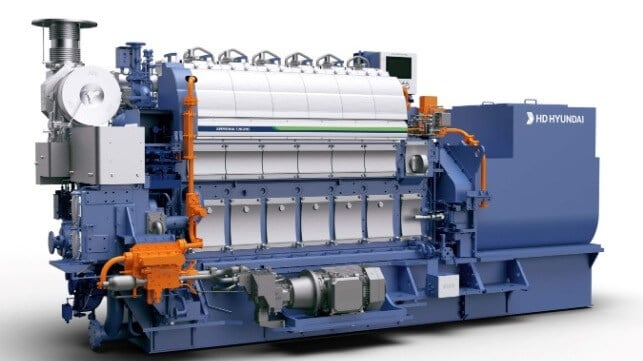HD Hyundai Claims Ammonia Engine First Using High-Pressure Injection

HD Hyundai Heavy Industries is claiming to have achieved a critical breakthrough in the development of ammonia-fueled engines using a unique high-pressure injection method. The South Korean shipbuilder says it achieved certification during model testing and is ready to begin commercialization of the engine.
The engine Hyundai reports uses a newly developed "high-pressure direct injection method" that compresses air in the engine combustion chamber and then burns it by injecting ammonia with high pressure. According to the company, this is the first ammonia engine in the world that has successfully applied a high-pressure ammonia direct injection method.
“Until now, ammonia engines were based on a ‘low-pressure premixed combustion method’,” says Hyundai, which they explained burns a mixture of ammonia and air, which has been provided to the engine combustion chamber, through compression. They are saying that despite the benefits of great output and fuel efficiency, engine companies around the world had difficulty developing this method due to its high technological complexity.
While setting up an optimized fuel spraying time and period to maximize the burn rate, HD Hyundai Heavy Industries reports it also utilized a selective catalytic reduction (SCR) system to minimize the amount of nitrogen oxide and unburned ammonia. In addition, an Integrated Scrubber developed independently by HD Korea Shipbuilding & Offshore Engineering has been widely applied resulting in a drastic reduction of ammonia concentrations.
"The development of this ammonia engine has great meaning as it will be an opportunity for us to lead the market while providing an expanded eco-friendly dual-fuel engine lineup," said an official of HD Hyundai Heavy Industries. "We aim to enhance our advanced technology and take the lead in the future eco-friendly ship market."
Model-based testing of the engine was completed on October 7 at Hyundai’s Engine Technology Center in Ulsan, South Korea. The testing was attended by representatives from seven classification societies including ABS, DNV, LR, BV, RINA, ClassNK, and KR.
They report that the engine is receiving model-based class approval from the seven major classification societies. The detailed examination and compliance review were finalized with the model-based class approval, and HD Hyundai Heavy Industries reports it will soon start commercialization of the HiMSEN ammonia engine.
HD Hyundai Heavy Industries says that the ammonia engine will be suitable not only for ammonia carriers but also for marine power generation and propulsion purposes. The company also plans to market the engine to the land-based power generation market.
This comes just weeks after Japan’s NYK reported it had completed the conversion of a tug to become the first to operate on ammonia as its primary fuel. They plan to begin operations in Tokyo Bay as part of a demonstration project. Singapore has been proceeding with the testing and certification of an offshore supply vessel converted for ammonia operations by Australia’s Fortescue while in the United States, a startup company Amogy demonstrating an ammonia cracking technology that produces hydrogen for fuel cells. They completed the first demonstration on a converted tugboat as they work to scale up their technology.
Major engine manufacturers including MAN and Wartsila have also reported strong progress on the development of their versions of ammonia-fueled engines. It is widely anticipated that the technology would begin to be deployed by 2026.
